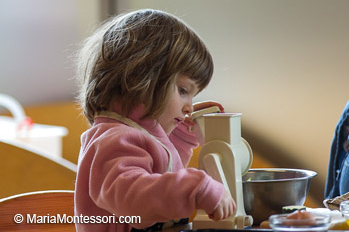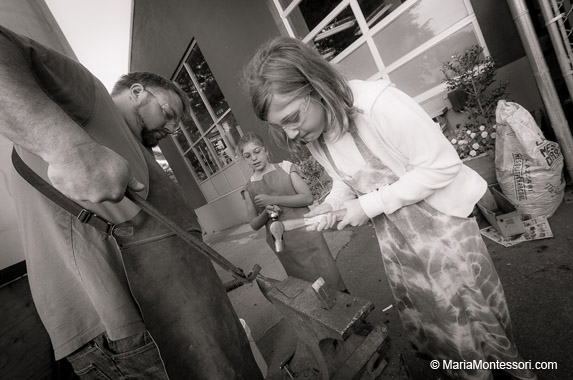November 2, 2022
The Foundational Preparation for Car Keys
How does the early introduction of matches, needles, and knives prepare our children for the responsibility of car keys at sixteen, eighteen, or later? What qualities do we hope for in a young person to whom we hand the car keys?
- Trust in us, appreciation for our trust in him, confidence that our concerns are real and well-founded;
- Intention, attention, and responsibility, and at such an early age, for the machine that kills and maims so many each year, and will likely do so to young people he knows well;
- Concentration, focus, and perseverance in holding those;
- Strong confidence and deep understanding of who he is—that he is capable and skillful and worthy so that he is not attracted to doing something dangerous to prove himself to his companions
Those are the very qualities we are building into the character of our children in our school through the use of such tools as matches, needles, and knives.
First, let’s begin with the introduction of each into the children’s lives in their Montessori community.
Knives: A serrated table knife or other serrated knives with a rounded tip is a standard tool in the Youngest Children’s Community. It is introduced following the child’s mastery of the two-handled chopping blade, which comes first because both of the child’s hands, and therefore fingers, are occupied well above the blade during the chopping process. As safe as this is, it is introduced with an air of caution and a hint of danger. The materials laid out for this activity feature the blade in a specific place, oriented in a specific direction. The strength of the guide’s intention is that this is a dangerous tool and must be handled with precision and care is brought to bear. The presentations with the two-handled chopping blade are always given with the fullest attention to detail in the lifting, holding, handling, and using of the tool as well as its placement on the tray while at rest.

When the child is seen to be responsible and skillful with the chopper, he is introduced to activities that include the blunt-tipped, serrated knife. It is more challenging because it has only one handle and that handle is close to the blade. One hand can be kept safe by holding that handle securely away from the blade, but the other hand must be kept safe by placing its palm on the non-cutting edge of the knife and holding all fingers and the thumb curved upwards. To distinguish the non-cutting edge of the knife from the serrated edge, the cutting edge is not left to observation for a child so young. The non-cutting edge is marked with a thin stripe of red plastic tape. In the activity set, the knife is placed always in the same place and in the same position on the tray. While in use it is always set down in exactly the same place in the same position. The guide does so with utmost attention and intention, conveying with her facial expression her exquisite care and respect for the knife and her recognition of its danger.
In turning the knife over to the child, the adult conveys this approach of seriousness respect and attention. She steps aside and observes to insure that the child is using the knife in this manner and with this attitude.
All of this intention, attention, and precision gives the child knowledge of several things:
- He is trusted by the adults in his life;
- He is recognized by the adult as capable of keeping himself and others safe through his own self-discipline;
- He is trusted to remember and persevere in taking great care with a dangerous tool;
- The adult has confidence and faith in him;
- He can trust that when the adult says no, there must be a very strong reason because the adult has shown respect by giving him dangerous tools to be used with great care and showing him how to use them;
- The adult will always do the very best to respect his desire to learn and do if it can possibly be made safe;
- He can use dangerous tools to carry out dangerous tasks because he has skill and intention.
Needles: At the very end of the Youngest Children’s Community, the child is introduced to the use of a needle. It is blunt but still, it is a needle and it is dangerous. The needle is kept in a small wooden cylinder with a tight lid. While in use it is inserted into a pin cushion when set aside for a moment. All the care of manner and method and bearing described above is given by the guide in introducing the use of the needle to the child.
The child moves up to the Children’s House and continues to build his skills at using needles and knives. He uses many other tools as well, each posing a new challenge and building his healthy self-esteem. He augments his understanding that he is trusted, worthy, skillful and responsible. Adults will not underestimate him. He need not show bravado in order to prove himself to himself or others. He need not take secret risks, hide his interests from adults or take what has not been presented to him. He will always be taken seriously and prepared to challenge himself when he is interested. He is supported to believe the adult.
When I was a Children’s House guide in the first five years after founding the school, a little girl in our community poked herself with a needle while sewing on a button. She left her work on the table and went around the room showing the children the tiny drop of blood on her finger and telling them to be careful with the needle because look what it could do! It was impressive and I was glad. The children could see that adults could be trusted to show children how to use a dangerous tool and to trust them to take care, even when they could get a safe little hurt, so when an adult said no, there must be a really strong reason.
Matches: In the elementary level, between the years of six and nine, most children learn to use a match for birthday candles and science experiments. The guide shows the children how to make themselves safe by rolling up their sleeves high and tight, pulling back their bangs with a headband and their hair with a ponytail holder, and belting their loose shirts and blouses. The matches are kept in a certain way and never opened without having a little dish of water or sand right there at hand. When striking matches children sometimes become panicked and want to throw the match as it suddenly bursts into flames.

Only one match at a time is kept in the striking box. The guide shows the children in a stylized way, slowly and dramatically, how to take out the match and close the box; how to hold the end of the match with the thumb and middle finger; how to support the match up toward the head with the index finger; how to remove the index finger from proximity to the flame as soon as it lights. This is done first with a match that has a burnt-out head. It is practiced over and over until the movement is automatic, and programmed into the muscle memory.
Next, the adult shows the child how to light a match, hold it vertically so it is oriented in the direction of the flame, then turn it horizontally so it can be pointed at what is to be lit, and then put it in the sand or water. When these actions become automatic, set in the muscle memory, it is time for the final step—lighting the candle. If the candle doesn’t catch before the flame gets too close to the child’s fingers, the child puts it into the water or the sand and lights another match. Each match is taken from the supply of matches one by one and put into the striking box.
Once the child can light a candle and snuff it out with a candle snuffer with confidence and ease, he is ready for further challenges. A nice refinement is for the child to learn to blow out the match, which can be quite funny because the first few times the child holds the match in front of him in front of the candle so that when he blows out the match, he also blows out the candle. It takes a few practices for him to remember to turn at a right angle from the candle before blowing out the match. Always the bowl of water or sand is right at hand.
During the elementary years, both early and upper, the child carries out science experiments that are progressively more challenging. In upper elementary, the child must pass a science safety test and receive certification before going forward to more challenging experiments.
So, over the long years from Youngest Children’s Community through Children’s House, Early and Upper Elementary, and the Adolescent Program, our children grow confident and capable, strong in their sense of who they are, and trusting of the adults who have been their supporters and empowered them along the way. This is the best way to prepare children for the day when we put a set of car keys in their hands. This is the value of matches, needles, and knives, and the uses for which we put them!